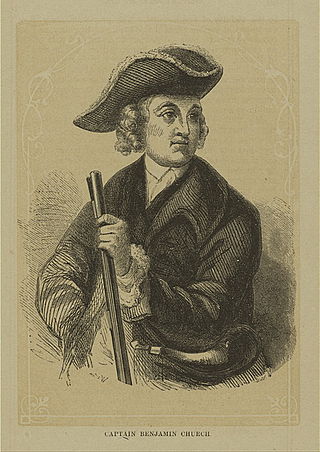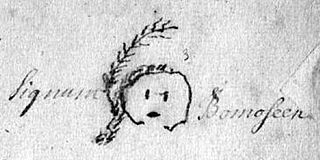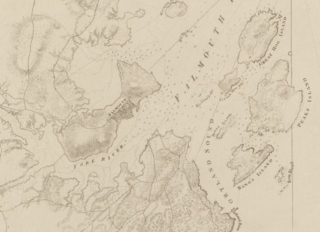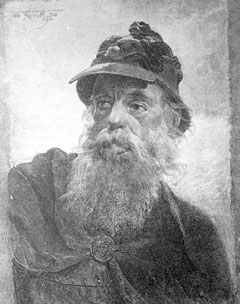
Falmouth is a town in Cumberland County, Maine, United States. The population was 12,444 at the 2020 census. It is part of the Portland–South Portland–Biddeford, Maine metropolitan statistical area.

King William's War was the North American theater of the Nine Years' War (1688–1697), also known as the War of the Grand Alliance or the War of the League of Augsburg. It was the first of six colonial wars fought between New France and New England along with their respective Native allies before France ceded its remaining mainland territories in North America east of the Mississippi River in 1763.

Casco Bay is an inlet of the Gulf of Maine on the southern coast of Maine, New England, United States. Its easternmost approach is Cape Small and its westernmost approach is Two Lights in Cape Elizabeth. The city of Portland sits along its southern edge and the Port of Portland lies within.

Colonel Benjamin Church was an American military officer and politician who is best known for his role in developing military tactics and participating in numerous conflicts which involved the New England Colonies. He is also known for commanding one of the first ranger units in North America. Born in the Plymouth Colony, Church was commissioned by Governor Josiah Winslow to establish a company of rangers after the outbreak of King Philip's War in 1675. A force of New Englanders led by him was responsible for tracking down and killing Wampanoag sachem Metacomet, which played a major role in ending the conflict.
The Treaty of Casco (1678) was a treaty that brought to a close the war between the Indigenous Dawnland nations and the English settlers. There are no surviving copies of the treaty or its proceedings, so historians use a summary by Jeremy Belknap in his 1784 History of New Hampshire.
Treaty of Casco (1703) was an unsuccessful attempt made by Governor Joseph Dudley of Massachusetts Bay Colony to prevent further Indian hostilities from breaking out along the northern frontier. War was already going on in Europe between England and France and the eastern Indians were historically allies of New France, and had a close relationship with the French Jesuits.

The Treaty of Portsmouth, signed on July 13, 1713, ended hostilities between Eastern Abenakis, a Native American tribe and First Nation and Algonquian-speaking people, with the British provinces of Massachusetts Bay and New Hampshire. The agreement renewed a treaty of 1693 the natives had made with Governor Sir William Phips, two in a series of attempts to establish peace between the Wabanaki Confederacy and colonists after Queen Anne's War.

The Burning of Falmouth was an attack by a fleet of Royal Navy vessels on the town of Falmouth, Massachusetts. The fleet was commanded by Captain Henry Mowat. The attack began with a naval bombardment which included incendiary shot, followed by a landing party meant to complete the town's destruction. The attack was the only major event in what was supposed to be a campaign of retaliation against ports that supported Patriot activities in the early stages of the American Revolutionary War.

The History of Portland, Maine begins when Native Americans originally called the Portland peninsula Məkíhkanək meaning “At the fish hook” in Penobscot and Machigonne in Algonquian. The peninsula and surrounding areas was home to members of the Algonquian-speaking Aucocisco branch of the Eastern Abenaki tribe who were forcibly relocated to current day Canada during European settlement.
Madockawando was a sachem of the Penobscot, an adopted son of Assaminasqua, whom he succeeded. He led the Penobscot on the side of the French against the English during King William's War.

Fort William Henry is located in the village of New Harbor in the town of Bristol, Maine. The fort was, in its time, the largest in New England. The fort was originally built in 1692 but destroyed four years later by New France in the Siege of Pemaquid (1696). A reconstruction was built in 1908. The fort was added to the National Register of Historic Places on December 1, 1969. Fort William Henry is now operated as a museum about the fort's history.

The Battle of Falmouth involved Joseph-François Hertel de la Fresnière and Baron de St Castin leading troops as well as the Wabanaki Confederacy in New Brunswick to capture and destroy Fort Loyal and the English settlement on the Falmouth neck, then part of the Massachusetts Bay Colony. The commander of the fort was Captain Sylvanus Davis. After two days of siege, the settlement's fort, called Fort Loyal, surrendered. The community's buildings were burned, including the wooden stockade fort, and its people were either killed or taken prisoner. The fall of Fort Loyal (Casco) led to the near depopulation of Europeans in Maine. Native forces were then able to attack the New Hampshire frontier without reprisal.

The siege of Pemaquid was a successful attack by a large band of Abenaki Indians on the English fort at Pemaquid, Fort Charles, then the easternmost outpost of colonial Massachusetts. The French-Abenaki attack was led by Jean-Vincent d'Abbadie de Saint-Castin and Father Louis-Pierre Thury and Chief Moxus. The fall of Pemaquid was a significant setback to the English. It pushed the frontier back to Casco (Falmouth), Maine.
The Northeast Coast campaign was the first major campaign by the French of Queen Anne's War in New England. Alexandre Leneuf de La Vallière de Beaubassin led 500 troops made up of French colonial forces and the Wabanaki Confederacy of Acadia. They attacked English settlements on the coast of present-day Maine between Wells and Casco Bay, burning more than 15 leagues of New England country and killing or capturing more than 150 people. The English colonists protected some of their settlements, but a number of others were destroyed and abandoned. Historian Samuel Drake reported that, "Maine had nearly received her death-blow" as a result of the campaign.
The Northeast Coast campaign (1723) occurred during Father Rale's War from April 19, 1723 – January 28, 1724. In response to the previous year, in which New England attacked the Wabanaki Confederacy at Norridgewock and Penobscot, the Wabanaki Confederacy retaliated by attacking the coast of present-day Maine that was below the Kennebec River, the border of Acadia. They attacked English settlements on the coast of present-day Maine between Berwick and Mount Desert Island. Casco was the principal settlement. The 1723 campaign was so successful along the Maine frontier that Dummer ordered its evacuation to the blockhouses in the spring of 1724.

The Maliseet militia was made up of warriors from the Maliseet of northeastern North America. Along with the Wabanaki Confederacy, the French and Acadian militia, the Maliseet fought the British through six wars over a period of 75 years. They also mobilized against the British in the American Revolution. After confederation, Maliseet warriors eventually joined Canada's war efforts in World War I and World War II.
The Battle of Falmouth was fought at Falmouth, Maine when the Canadiens and Wabanaki Confederacy attacked the English New Casco Fort. The battle was part of the Northeast Coast Campaign (1703) during Queen Anne's War.
Shadrach Walton was a British colonial administrator and soldier in the Province of New Hampshire.

Fort Casco was an English fort built in present-day Falmouth, Maine in 1698. It was the easternmost English fortification in New England and served as the boundary between English settlement and Wabanaki territory.
Hannah Swarton, née Joana Hibbert/Hibbard, was a New England colonial pioneer who was captured by Abenaki Indians and held prisoner for 5+1⁄2 years, first in an Abenaki community and later in the home of a French family in Quebec. She was eventually freed and told her story to Cotton Mather, who used it as a moral lesson in several of his works.











